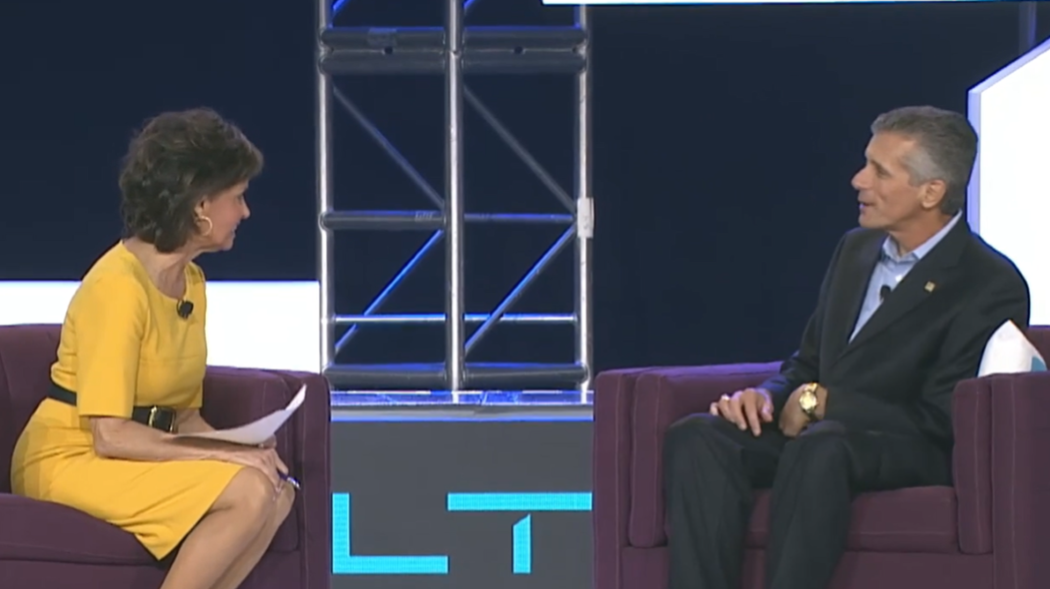
Highlights:
- Health care is transforming, with three primary forces of change.
- Technology presents an opportunity to bring personalized care to the individual, and also extend the care team.
- The Economist recently published research about the importance and business case for workforce health promotion, and tangible steps employers can take.
- To navigate the continued pandemic, companies must stay true to their mission and values, have a strong team, and be prepared for quick decision-making.
The ongoing consensus at this week’s HLTH 2021 conference in Boston is that the health care industry is in the midst of a massive transformation.
Fortune Anchor and Senior Special Correspondent Susie Gharib sat down with Cigna President and CEO David Cordani for a fireside chat on what the future of health care will look like. According to Cordani, there are three major forces at play – pharmaceutical innovation, alternative sites of care, and an increased focus on whole-person health – that will transform health care as we know it over the next decade.
“These three transformative forces are well at work today, and in many ways COVID has super-charged the activity around these [trends],” Cordani told attendees.
Pharmaceutical Innovation
The last year has been like no other for pharmaceutical innovation. Beyond the rollout of the COVID vaccines, the industry has also made progress in developing drug treatments for a number of diseases. Cordani acknowledged that in pharmaceuticals, innovation comes at a premium.
“When you deliver value you have to get the right balance of affordability and quality,” he said, adding that if the U.S. was leveraging biosimilar medications at the rate of other OECD countries, it would mean about $300 billion in savings, which can be used to fund additional innovation.
Additionally, Cordani said that we will see “more precision” around the use of specialty medications and how they are targeted to individuals through coordinated care. He also said that for payers, partnering with the drug manufacturers to pay based on clinical outcomes and not just consumption will be important.
“The key is going to be making sure we work with information and the practicing physician to make sure we get the right medicine to the right person through the right site of care, and collaborating with the health care manufacturers to make sure that the reward structure is based on the clinical outcome and not just on consumption,” Cordani said.
That requires clinical programs to be wrapped around an individual in order to yield the right outcome. These programs must include things like medication compliance – helping individuals stay on their medication – as well as coordinating the services around that. It’ll also take medical, pharmaceutical and behavioral resources to get the right level of precision in quality care for each individual, he said.
“As we move forward into specialty pharmaceuticals, the precision there is mission-critical,” Cordani said.
Alternative Sites of Care
In the United States, the vast majority of care that is consumed today happens in a facility. This means that the patient needs to leave their home, and go to a site of care. And that’s necessary sometimes, but not in all cases, Cordani said.
Technology, he added, gives us the opportunity to bring personalized care to the individual and it also has the ability to extend the care team (i.e. oncologists, behavioral specialists and other health care professionals that there is a great demand for, but not enough supply).
Cordani was confident in the opportunity with coupling the physical and digital worlds to bring individuals more personalized care. For example, think of the opportunity that comes with having a care resource such as a nurse or a nurse practitioner come into someone’s home, coupled with a telehealth appointment where the physician and nurse work together to provide targeted care that is enabled through technology.
“We see it as an extension of the medical professional and we see it as a more personalized way to deliver care,” Cordani said, “and in many ways a more affordable way to deliver coordinated care.”
The global CEO also said that the consumerization of health care is here, as consumers have come to expect the same level of convenience in health care as they see in other industries such as finance and retail. At the same time, we are seeing under-use (in services and offerings) of virtual care and home care. That’s why, he said, we need more coordinated care through the medical professional that an individual sees as their gateway to care, whether it’s a primary physician or otherwise, and then looking at clinics, home health and virtual care as being coordinated around that.
The key, Cordani added, is going to be capturing and utilizing data to make care more personalized. “Consumer expectations were already elevated relative to having service in health care more akin to other services they consume in their life in terms of personalized, immediate and convenient,” Cordani said. “COVID showed that it is possible, less through the physical infrastructure and more through the virtual infrastructure. If you look at the amount of virtual care consumed during the COVID pandemic, it went up not 10 times, not 15 times, but quantum times in consumption.”
He expects this trend towards virtual care to continue to accelerate to the point where it becomes the primary source of care for situations where a patient doesn’t need to be in-person, such as behavioral health care.

Using the MDLIVE Telehealth Platform is as Easy as One, Two, Three
Virtual care is here to stay. Millions of people have already received quality medical care with MDLIVE and 9 out of 10 would recommend it.
Whole Person Health
Half of Americans receive health care through their employer sponsored insurance. And 80% of individuals are feeling the stress, strain, etc., that has come about due to the pandemic. The good news is that 90% of employers recognize that if they invest in the health, wellness and productivity of their workforce they will have a healthier business, according to a study by the Economist, which was sponsored by Cigna. “There’s an opportunity here for invention” Cordani said, adding that healthy workforce programs need to be designed with a consultative tone.
Incentives will also be key. The problem is, Cordani said, there isn’t a one-size-fits-all approach to incentives. Every individual is different and will have various health care needs. For employers this means looking at your culture, health burden, readiness to change, and the strategy, and then personalizing and designing programs from that viewpoint.
“You can’t just tell people what to do,” Cordani warned. “You [must] support them with information and most importantly you’re trying to find out what is important to each individual, and trying to help them in their life and health journey.”
At the end of the fireside chat Cordani spoke to the fact that in today’s climate, companies need a different type of leadership. The pandemic has reinforced there is no playbook, he said.
“In an environment of rapid transformative change [CEOs must] be guided by the [company] mission and values system, have a great team, be prepared to make decisions and move quickly,” he said.